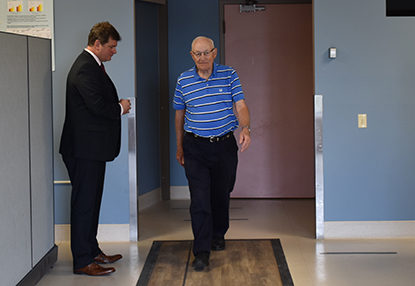Research News: Difference in walking pattern can predict type of cognitive decline

Canadian researchers are the first to study how different patterns in the way older adults walk could more accurately diagnose different types of dementia and identify Alzheimer’s disease.
A new study by a Canadian research team, led by London researchers from Western University and Lawson Health Research Institute, evaluated the walking patterns and brain function of 500 participants currently enrolled in clinical trials. Their findings are published in Alzheimer's & Dementia: The Journal of the Alzheimer's Association.
“We have longstanding evidence showing that cognitive problems, such as poor memory and executive dysfunction, can be predictors of dementia. Now, we’re seeing that motor performance, specifically the way you walk, can help diagnose different types of neurodegenerative conditions,” said Dr. Manuel Montero-Odasso, Professor at Western’s Schulich School of Medicine & Dentistry and Scientist at Lawson.
 Dr. Montero-Odasso is world renowned for his research on the relationship between mobility and cognitive decline in aging. Leading the Mobility, Exercise and Cognition team in London, he is pioneering new diagnostic approaches and treatments to prevent and combat early dementia. Dr. Montero-Odasso is also co-lead of the Mobility, Exercise and Cognition Team at the Canadian Consortium on Neurodegeneration of Aging (CCNA), a team composed of 22 researchers and 6 trainees.
Dr. Montero-Odasso is world renowned for his research on the relationship between mobility and cognitive decline in aging. Leading the Mobility, Exercise and Cognition team in London, he is pioneering new diagnostic approaches and treatments to prevent and combat early dementia. Dr. Montero-Odasso is also co-lead of the Mobility, Exercise and Cognition Team at the Canadian Consortium on Neurodegeneration of Aging (CCNA), a team composed of 22 researchers and 6 trainees.
This study compared gait impairments across the cognitive spectrum, including people with subjective cognitive impairment, Parkinson’s disease, mild cognitive impairment, Alzheimer’s disease, Lewy body dementia and frontotemporal dementia, as well as cognitively healthy controls. The study used data from the COMPASS-ND Cohort and from the Gait and Brain Study Cohort.
Four independent gait patterns were identified: rhythm, pace, variability and postural control. High gait variability was associated with lower cognitive performance and it identified Alzheimer’s disease with 70 per cent accuracy. Gait variability means the stride-to-stride fluctuations in distance and timing that happen when we walk.
“This is the first strong evidence showing that gait variability is an important marker for processes happening in areas of the brain that are linked to both cognitive impairment and motor control,” said Dr. Frederico Perruccini-Faria, Research Assistant at Lawson and Postdoctoral Associate at Schulich Medicine & Dentistry, who is first author on the paper. “We’ve shown that high gait variability as a marker of this cognitive-cortical dysfunction can reliably identify Alzheimer’s disease compared to other neurodegenerative disorders.”
Dr. Montero-Odasso adds that this gait variability could be perceived as similar to an arrhythmia. Health care providers could potentially measure it in clinical settings, like how heart rhythm is assessed with electrocardiograms.
“Having gait variability as a motor marker for cognitive decline and different types of conditions could allow for gait assessment to be used as a clinical test, for example having patients use wearable technology,” said Dr. Richard Camicioli, Professor at the University of Alberta and co-senior author on the paper.
The London team collaborated with researchers at the University of Toronto, University of Calgary and University of Alberta. They are part of the Canadian Consortium on Neurodegeneration of Aging (CCNA), a collaborative research program tackling the challenge of dementia and other neurodegenerative illnesses.
This study was primarily funded by CCNA, supported by a grant from the Canadian Institutes of Health Research.








